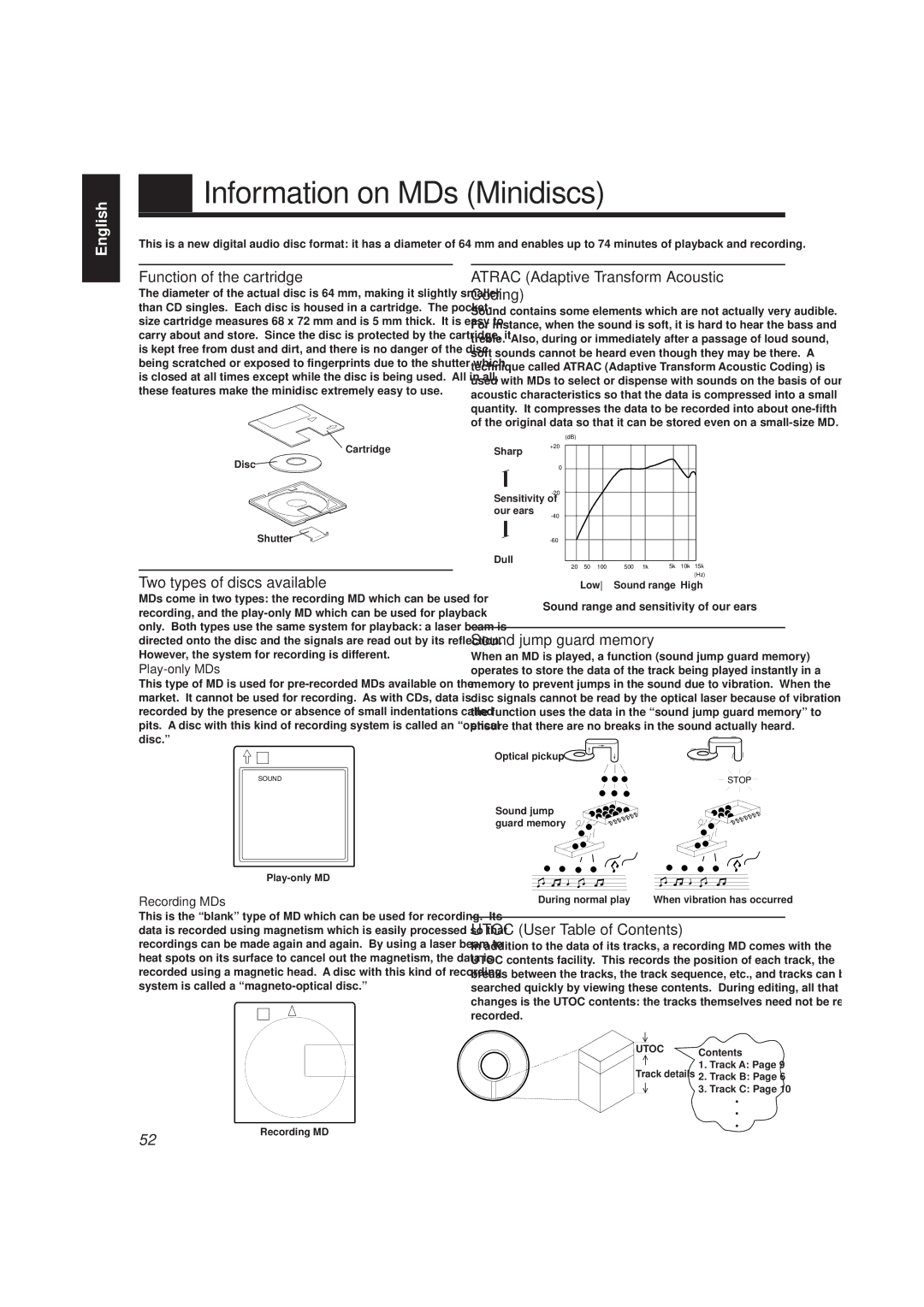
English
Information on MDs (Minidiscs)
This is a new digital audio disc format: it has a diameter of 64 mm and enables up to 74 minutes of playback and recording.
Function of the cartridge
The diameter of the actual disc is 64 mm, making it slightly smaller than CD singles. Each disc is housed in a cartridge. The pocket- size cartridge measures 68 x 72 mm and is 5 mm thick. It is easy to carry about and store. Since the disc is protected by the cartridge, it is kept free from dust and dirt, and there is no danger of the disc being scratched or exposed to fingerprints due to the shutter which is closed at all times except while the disc is being used. All in all, these features make the minidisc extremely easy to use.
Cartridge
Disc
Shutter
Two types of discs available
MDs come in two types: the recording MD which can be used for recording, and the
This type of MD is used for
SOUND
Recording MDs
This is the “blank” type of MD which can be used for recording. Its data is recorded using magnetism which is easily processed so that recordings can be made again and again. By using a laser beam to heat spots on its surface to cancel out the magnetism, the data is recorded using a magnetic head. A disc with this kind of recording system is called a
ATRAC (Adaptive Transform Acoustic Coding)
Sound contains some elements which are not actually very audible. For instance, when the sound is soft, it is hard to hear the bass and treble. Also, during or immediately after a passage of loud sound, soft sounds cannot be heard even though they may be there. A technique called ATRAC (Adaptive Transform Acoustic Coding) is used with MDs to select or dispense with sounds on the basis of our acoustic characteristics so that the data is compressed into a small quantity. It compresses the data to be recorded into about
|
|
| (dB) |
|
|
|
|
|
|
| |
Sharp | +20 |
|
|
|
|
|
|
|
| ||
|
|
|
|
|
|
|
|
| |||
\ | 0 |
|
|
|
|
|
|
|
| ||
|
|
|
|
|
|
|
|
|
| ||
|
|
|
|
|
|
|
|
|
| ||
Sensitivity of |
|
|
|
|
|
|
|
| |||
|
|
|
|
|
|
|
|
| |||
our ears |
|
|
|
|
|
|
|
| |||
|
|
|
|
|
|
|
|
|
| ||
|
|
|
|
|
|
|
|
|
|
| |
\ |
|
|
|
|
|
|
|
| |||
Dull |
|
|
|
|
|
|
|
|
| ||
20 | 50 | 100 | 500 | 1k | 5k | 10k | 15k | ||||
|
| ||||||||||
(Hz)
Low Sound range \High
Sound range and sensitivity of our ears
Sound jump guard memory
When an MD is played, a function (sound jump guard memory) operates to store the data of the track being played instantly in a memory to prevent jumps in the sound due to vibration. When the disc signals cannot be read by the optical laser because of vibration, the function uses the data in the “sound jump guard memory” to ensure that there are no breaks in the sound actually heard.
Optical pickup
STOP
Sound jump guard memory
During normal play | When vibration has occurred |
UTOC (User Table of Contents)
In addition to the data of its tracks, a recording MD comes with the UTOC contents facility. This records the position of each track, the breaks between the tracks, the track sequence, etc., and tracks can be searched quickly by viewing these contents. During editing, all that changes is the UTOC contents: the tracks themselves need not be re- recorded.
52
Recording MD
UTOC | Contents | ||
| |||
Track details | 1. | Track A: Page 9 | |
2. | Track B: Page 6 | ||
| |||
| 3. | Track C: Page 10 | |
|
| • | |
|
| • | |
|
| • | |
